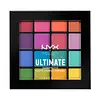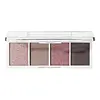What's inside
What's inside
 Key Ingredients
Key Ingredients

 Benefits
Benefits

 Concerns
Concerns

 Ingredients Side-by-side
Ingredients Side-by-side

Talc
AbrasiveMagnesium Stearate
Cosmetic ColorantDimethicone
EmollientHydrogenated Polyisobutene
EmollientOctyldodecyl Stearoyl Stearate
EmollientBis-Diglyceryl Polyacyladipate-2
EmollientTocopherol
AntioxidantEthylhexylglycerin
Skin ConditioningPhenoxyethanol
PreservativeMica
Cosmetic ColorantCI 77891
Cosmetic ColorantIron Oxides
CI 42090
Cosmetic ColorantCI 75470
Cosmetic ColorantCI 77007
Cosmetic ColorantCI 19140
Cosmetic ColorantAlumina
AbrasiveTriethoxycaprylylsilane
CI 77742
Cosmetic ColorantTin Oxide
AbrasiveCI 77120
Cosmetic ColorantCI 15850
Cosmetic ColorantCI 45410
Cosmetic ColorantTalc, Magnesium Stearate, Dimethicone, Hydrogenated Polyisobutene, Octyldodecyl Stearoyl Stearate, Bis-Diglyceryl Polyacyladipate-2, Tocopherol, Ethylhexylglycerin, Phenoxyethanol, Mica, CI 77891, Iron Oxides, CI 42090, CI 75470, CI 77007, CI 19140, Alumina, Triethoxycaprylylsilane, CI 77742, Tin Oxide, CI 77120, CI 15850, CI 45410
Mica
Cosmetic ColorantTalc
AbrasiveSynthetic Fluorphlogopite
Caprylic/Capric Triglyceride
MaskingBoron Nitride
AbsorbentSilica
AbrasiveMagnesium Stearate
Cosmetic ColorantMagnesium Palmitate
Tridecyl Trimellitate
EmollientNylon-12
Magnesium Myristate
Dimethicone
EmollientBis-Diglyceryl Polyacyladipate-1
EmollientPhenyl Trimethicone
Skin ConditioningPolyisobutene
Phenoxyethanol
PreservativeCaprylyl Glycol
EmollientTriethoxycaprylylsilane
Tin Oxide
AbrasiveCI 77499
Cosmetic ColorantCI 77491
Cosmetic ColorantCI 77891
Cosmetic ColorantCI 77742
Cosmetic ColorantCI 77492
Cosmetic ColorantMica, Talc, Synthetic Fluorphlogopite, Caprylic/Capric Triglyceride, Boron Nitride, Silica, Magnesium Stearate, Magnesium Palmitate, Tridecyl Trimellitate, Nylon-12, Magnesium Myristate, Dimethicone, Bis-Diglyceryl Polyacyladipate-1, Phenyl Trimethicone, Polyisobutene, Phenoxyethanol, Caprylyl Glycol, Triethoxycaprylylsilane, Tin Oxide, CI 77499, CI 77491, CI 77891, CI 77742, CI 77492
 Reviews
Reviews

Ingredients Explained
These ingredients are found in both products.
Ingredients higher up in an ingredient list are typically present in a larger amount.
This ingredient is used to add a violet color to cosmetics.
It is created by reacting phosphoric acid, ammonium dihydrogen orthophosphate, and manganese dioxide.
Ci 77891 is a white pigment from Titanium dioxide. It is naturally found in minerals such as rutile and ilmenite.
It's main function is to add a white color to cosmetics. It can also be mixed with other colors to create different shades.
Ci 77891 is commonly found in sunscreens due to its ability to block UV rays.
Learn more about CI 77891Dimethicone is a type of synthetic silicone created from natural materials such as quartz.
What it does:
Dimethicone comes in different viscosities:
Depending on the viscosity, dimethicone has different properties.
Ingredients lists don't always show which type is used, so we recommend reaching out to the brand if you have questions about the viscosity.
This ingredient is unlikely to cause irritation because it does not get absorbed into skin. However, people with silicone allergies should be careful about using this ingredient.
Note: Dimethicone may contribute to pilling. This is because it is not oil or water soluble, so pilling may occur when layered with products. When mixed with heavy oils in a formula, the outcome is also quite greasy.
Learn more about DimethiconeMagnesium Stearate is a salt that is 2 parts stearic acid and 1 part magnesium.
It is a white powder that can be used to add bulk and color to products by binding to oil ingredients.
Mica is a naturally occurring mineral used to add shimmer and color in cosmetics. It can also help improve the texture of a product or give it an opaque, white/silver color.
Serecite is the name for very fine but ragged grains of mica.
This ingredient is often coated with metal oxides like titanium dioxide. Trace amounts of heavy metals may be found in mica, but these metals are not harmful in our personal products.
Mica has been used since prehistoric times throughout the world. Ancient Egyptian, Indian, Greek, Roman, Aztec, and Chinese civilizations have used mica.
Learn more about MicaPhenoxyethanol is a preservative that has germicide, antimicrobial, and aromatic properties. Studies show that phenoxyethanol can prevent microbial growth. By itself, it has a scent that is similar to that of a rose.
It's often used in formulations along with Caprylyl Glycol to preserve the shelf life of products.
Talc is a clay mineral. It helps absorb moisture and improve the texture of products. Like other types of clay, Talc can have a slight exfoliating effect on skin. Talc can be added to increase the volume of products.
Some Baby powders are made by combining talc with corn starch. The word "talc" comes from Latin and originates from Arabic. Talc is a mineral commonly found throughout the world.
If you have any concerns about using talc, we recommend checking out the FDA's official page.
Learn more about TalcTin Oxide is an inorganic oxide used to add opacity and volume to a product. In nature, it is already found in mineral form. The main ore of tin is an opaque and shiny mineral called casseterite.
Tin Oxide helps remove translucency in a product, or make it more opaque. Besides adding opacity, tin oxide is used for bulking to add volume.
Triethoxycaprylylsilane is a silicone used to bind and stabilize ingredients.
As an emulsifier, it helps prevent ingredients from separating. This can help elongate the shelf life of products.
Triethoxycaprylylsilane is often used to coat mineral sunscreens ingredients to help give a better feel. It also helps reduce oxidative stress in sunscreens.
Learn more about Triethoxycaprylylsilane